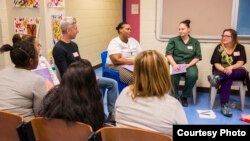Approximately 70,000 mothers are serving time in U.S. prisons. They rarely see their children, get to touch them, or even sing them a lullaby.
Female inmates in New York City are getting a little help with that last item, thanks to Carnegie Hall.
For the last few years, Carnegie’s sponsored the Lullaby Project, which pairs professional musicians with women in jails, homeless shelters and city hospitals, among other places, to help them write lullabies for their children.
On a frigid February morning, at New York City’s largest jail, Rikers Island, five musicians sit in a circle with 10 prisoners - women who are either detainees awaiting trial or who are serving out their sentences at Rikers Island.
To break the ice, Deidre Rodman Struck, a singer and songwriter who’s been working with the Lullaby Project since 2011, has everyone sit in a circle and sing a lullaby, incorporating the women’s names.
After an hour of getting to know each other, it’s time to write their own lullabies. The women go to different corners of the classroom, where they start by writing letters to their children, in workbooks. There are some suggestions: start sentences with “I hope, I wish, or I wonder.”
One of the Carnegie Hall teaching artists, singer/songwriter Daniel Levy, said it’s a difficult assignment.
“Well, the first thing you ask for is 'write down something you really care about.' So, you asking people to really open up their hearts," he said.
"And they don’t know me; they don’t know the other people in the room. But, you’re trying to get something that’s real into the song; like any songwriter wants that; like, a piece of truth.”
Levy worked with a woman named Vateya, who agreed it was difficult.
“I actually have a headache, because I was very focused! And, at first, I was like, I can’t do this; this is too hard. But, they kept telling me to write, whatever. And that’s what I did,” she said.
An emotional experience
In another corner of the room, a woman named Kelly worked with Indian classical singer Falu Shah. The two of them quickly come up with a chorus, but Shah said she really had to coax Kelly to write her lullaby.
"She was actually crying; she was very sad. And, you know, we were talking about our kids; her child and my child. And we just connected, becoming mothers for a second, because she was unable to write anything," Shah said.
"So, I started talking to her about my son and she started talking to me about her four children. And that’s where I could get this hurt out from her, because sometimes a participant needs a personal touch. They need to know that I’m safe," she continued.
The song is written from two perspectives - Kelly’s and that of the children’s late father.
"Fortunately, the two younger children, they don’t know much about what’s going on. And even though me and him weren’t together, he was there for the children," Kelly said.
"And so I really wanted to get the message, to the older ones especially, that their father’s still around, and that he’s looking down on them, so that they can feel some sort of comfort, since I can’t be there, physically,” she said.
To be able to give those children something … anything … means a lot, said Veronica Scudder, who helps coordinate programs for the women at Rikers Island.
“For them to have the opportunity to write a song for their children is really, really a nice feeling. And that’s where you see their face light up, because they feel like, ‘Wow. I’m really doing something. And I’m doing it in a jail.’ That’s unheard of,” Scudder said.
Professional recordings
When the day ends, the musicians leave, and get down to the business of transcribing, arranging and polishing the lullabies.
"The minute I left Rikers,” Shah recalled, “we came home, we charted down everything that was on the recording, line by line, who wanted what, tunes - because we have to learn the melodies."
"And then think about what the arrangements will be like. So that process starts right away," she said.
One week later, the musicians met in a Manhattan recording studio, to lay down tracks.
Deidre Struck, who worked with a mother who had lost one of her children, gave the woman’s lullaby a Latin feel. “Strangely, her story is so sad, but the song is so happy. I’m hoping it captures what she wanted to say.”
That’s crucial, said Levy.
“The most important thing for all of us is that we’re collaborating with the women, so you have to keep them and their children and their wishes foremost in your mind,” he said.
A week after the recording sessions, the musicians went back to Rikers with their co-songwriters, to perform the finished lullabies.
Kelly is overwhelmed by Falu’s setting of her lullaby.
“Now that I’ve heard everybody’s songs, it’s just…they’re all so beautiful. I mean, you know, where, I guess it’s…when it comes to our children, maybe it brings out the best in us. You know, we all became songwriters for them, right?” she observed with a laugh.
After an intense private hour, the musicians do two concerts of all the lullabies in a gymnasium for many of the other women prisoners - and each of the participants gets to take a bow after her song.
The Lullaby Project is expanding beyond New York City and Carnegie Hall - several arts organizations around the country have begun their own lullaby projects.












